- Fact Checked
Last Updated: August 11, 2022
Vegan mayo is an excellent alternative for those who enjoy the taste of mayo, minus the animal by-products. Regular mayo is made with eggs and some other ingredients that aren’t very healthy, including saturated fats.
Luckily, vegan mayo contains fewer calories than regular mayonnaise, which may be able to aid in weight loss.
Another great thing about vegan mayo is it’s pretty easy to make at home. There are different ways you can go about making it and various ways to flavor it.
Ensuring you properly mix it, however, is an essential factor in whether or not your mayo comes out correctly. So let’s look at how to make vegan mayo that will enhance any sandwich and is perfect for dipping french fries.
Yes, vegan mayo exists and comes in many tastes for every kind of palate. Vegan mayo has been famous for quite some time and first came on the scene in the ‘70s.
Vegan mayo was first invented in 1970 by Follow Your Heart Cafe, which later founded the household name vegan mayo, Veganaise. Other household names followed suit, such as:
While many store-bought vegan mayo alternatives taste incredible, they often contain more calories and processed ingredients. If you’re looking for a healthier, sustainable alternative to regular mayonnaise that doesn’t use any animal products, homemade vegan mayo is a perfect solution.
Homemade sauces tend to contain fewer calories and saturated fats as they can be made with healthier oils.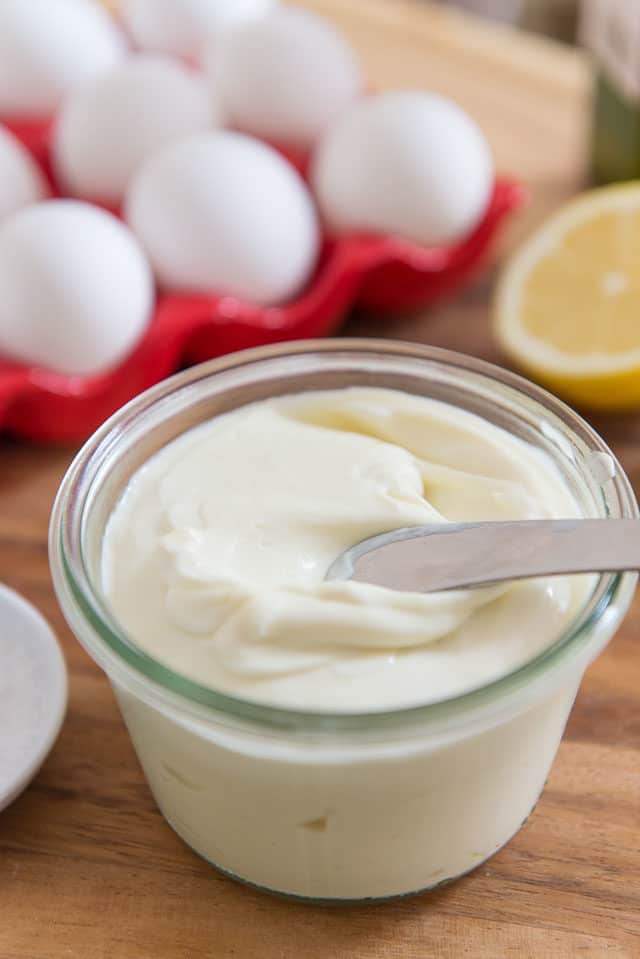
Wondering how to make vegan mayo? Luckily, making vegan mayo at home is simple and doesn’t require many ingredients.
Here’s what you’ll need to create a tangy, creamy plant-based mayo:
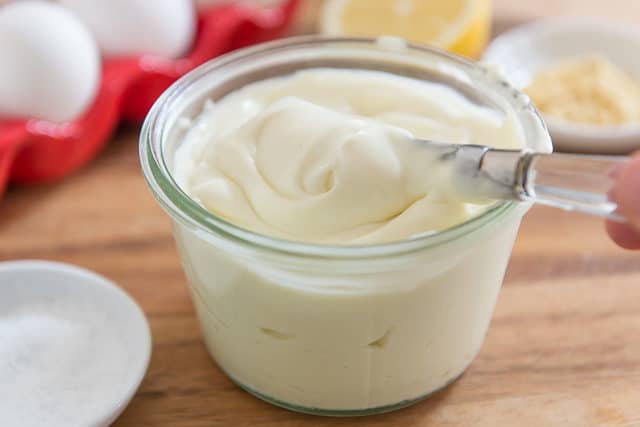
You can also swap out the vinegar for apple cider vinegar if you don’t have any in your pantry.
The main ingredients that create a creamy dipping sauce are neutral oil and soy milk. It’s best to use soy milk that’s unsweetened. If you don’t want soy milk, you can opt for aquafaba.
Whether you use soy milk or aquafaba, the result is still delicious. Of course, you can put any seasonings or spices you’d like. Many people enjoy adding roasted garlic to their homemade mayo to give it a robust flavor.
If you’re wanting a simple mayo, it’s best to use vinegar, lemon juice, salt, and a sweetener for the perfect balance of savory with a hint of sweetness.
This mayo will last around two weeks in the fridge.
The blending process is a big part of making vegan mayo at home successfully. If it’s not blended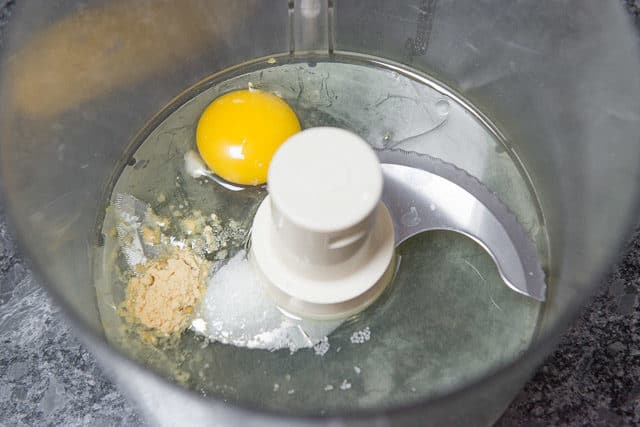 correctly, your mayo won’t be thick enough. It may also have a strange consistency.
correctly, your mayo won’t be thick enough. It may also have a strange consistency.
To ensure you create the creamiest mayo possible, consider using a food processor or an immersion blender.
Here’s how to blend your mayo using an immersion blender and a food processor.
In a glass jar, mix the salt, mustard, and vinegar. You can also mix it with the cup included with the blender.
Next, blend all the ingredients on high in the immersion blender until it gets thick.
While the blender is still going, slowly pour in the oil. You must add it in very slowly. It may take a couple of minutes, but you’re on the right track once it firms up a fair bit.
Once you’ve added all the oil, gently move the blender in an up and down motion. This movement will help to loosen it up and allow air to enter.
If it’s too loose, add a tiny amount of more oil until it thickens. Otherwise, leave it in the fridge, which will help it set.
Put the soy milk into the food processor for one minute so it can thicken. Next, pour in the salt, mustard, vinegar, and lemon juice. Process everything for 30 more seconds.
To emulsify correctly, add the oils slowly. Add it one tablespoon at a time if you’re blending with a food processor.
Now you can taste the mixture and tweak the flavor with more salt or anything it may need more of.
Next, place the mixture in the fridge for a few hours to set. If it’s still loose once you take it out, you can always blend it again until it thickens.
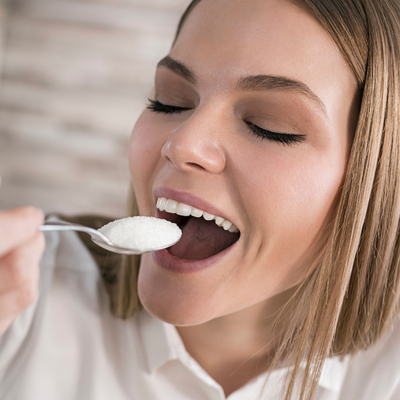
Vegan mayo tastes like regular mayonnaise, except it’s made without eggs. The wonderful thing about vegan mayo is that there are many different flavors for every palate.
There’s also a flavor for every type of meal. But some vegan mayos may be tangier or a little sweeter than others.
Another fantastic thing about vegan mayo is that if you feel like changing the flavor, you can add other sauces to create a special blend of flavors.
Here are some excellent vegan mayo options from reputable brands.
Sir Kensington’s Classic Vegan Mayo is ideal for those who prefer one without any sweeteners. It’s packed full of flavor since it contains lemon oil, black pepper, mustard extract, and lemon juice.
The consistency is not too thick and is a delicious dipping sauce or topping. If you’re not sold on the classic flavor, the brand has three other vegan mayo options, including:
If you’re a fan of sauces that add a flavorful kick to your food, the Primal Kitchen Rosemary Garlic Mayo is the perfect addition to your fridge.
The garlic adds a delicate yet bold flavor, and it pairs perfectly with the subtle kick of rosemary. This mayo also has an avocado base, which gives it an even smoother texture and creamier taste.
Hellman’s Vegan Mayo tastes similar to its non-vegan counterpart, but it’s much healthier. It’s perfectly creamy in texture and rich in flavor. You wouldn’t be able to tell it apart from the original version.
It also contains modified food starch, used to help the mayo emulsify in place of eggs. Sunflower oil is also used in place of soybean oil, which is typically in the non-vegan version of Hellman’s.
Their vegan mayo isn’t as oily as their non-vegan mayo. Overall it’s a flavorful and light alternative.
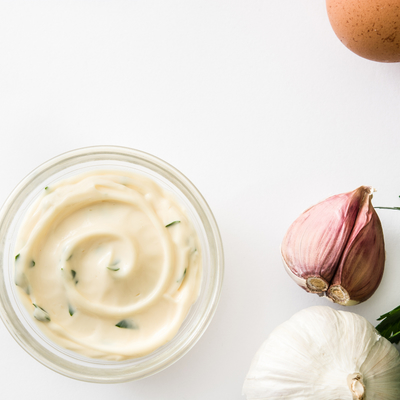
One of the many benefits of mayo is that it’s versatile. There are several recipes and varieties of foods that vegan mayo compliments perfectly.
This perfect pairing is partly due to its creamy texture and array of tastes. So whether you’re craving something savory or if you want to make fluffy desserts, the possibilities are endless for how you can use vegan mayo.
Some foods and recipes that you can create with vegan mayo include:
It’s important to note that if you buy a particular flavor of vegan mayo, the taste will vary. So ensure you use a vegan mayo that will complement the specific taste of the dish to which you’d like to add it.
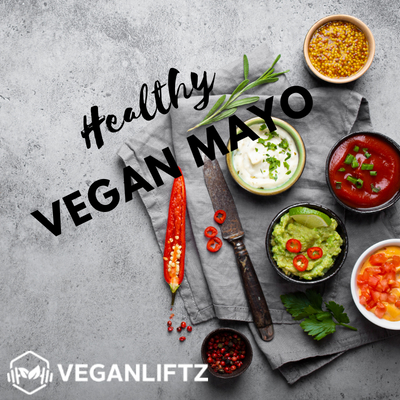
Vegan mayo, in theory, is healthier than regular mayo. However, store-bought vegan mayo may not be as healthy as it seems.
Unfortunately, some store-bought brand-name vegan mayo is usually filled with unhealthy, processed ingredients. These mayonnaises tend to be high in sodium, refined oils, and calories.
Despite this, some store-bought brands are still safe options, such as Just mayo. It only contains 60 calories per tablespoon. That’s a little over 30% lower than the majority of mayonnaise brands.
With a few exceptions, most vegan mayos are also made with clean ingredients. But, making vegan mayo at home is the best way to ensure you’re eating quality ingredients.
If you make your mayo, you can control how much oil and salt go into the mixture. You also get to adjust the mixture according to your dietary restrictions and personal taste. If you’re hoping for a spicy kick, you can add sriracha or hot sauce. And if you prefer a bold flavor, adding roasted garlic will take your homemade vegan mayo to the next level.
Above we discussed how to make vegan mayo. Luckily, making vegan mayo is something that anyone can do, and it won’t cost you a lot of money. If you enjoy being creative in the kitchen, you can experiment with a range of flavors and test out different recipes until you find the one that’s best for you.
You can use vegan mayo on just about anything, and it will add that extra kick to any dish. Remember that homemade mayo generally doesn’t have a long shelf life.
[thrive_leads id=’11437′]
Resources:
https://www.self.com/gallery/best-vegan-mayos
https://www.hellmanns.com/us/en/products/organic-vegan/vegan-dressing-spread.html
https://www.primalkitchen.com/pages/vegan-mayo
https://www.sirkensingtons.com/product/vegan-mayo
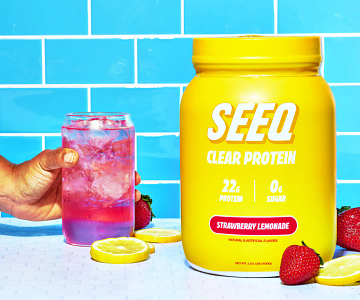

Address: 1300 Avenida Vista Hermosa, San Clemente, CA 92673, United States | Phone Number: +1 (949) 248-0131 | Email: contact@veganliftz.com